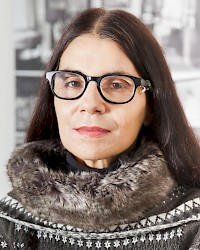Vita
Silvia Fômina is a composer, author and stage director specialized in polyphonic music, micro-tonality and micro rhythmics. From 1989 to 1991 she hold a scholarship of the DAAD and has been a particular student of the composer György Ligeti in Hamburg since then for 13 years. Fômina was awarded with the First Prize at the Vienna International Composition Competition (1991) and with the Prize of the Academy of Arts in Munich donated by the Ernst-von-Siemens Foundation for her research in instrumental micro-tonal composition in 1993. Between 1994 and 2015 she has been Artist in Residence at several institutions throughout the world, e.g. at Djerassi Resident Artist Program in Woodside and San Francisco CA, USA (1994/2002/2011), Cité Internationale des Arts in Paris (1995-96), Academy Castle Solitude in Stuttgart, Germany (1999), Wurlitzer Foundation” in Taos NM, USA (2003-04), Tyrone Guthrie Centre Ireland (2009) and Deutsches Studienzentrum in Venedig in Venice (2015). Fômina produced several commission works, e.g. for Westdeutscher Rundfunk Cologne (1991) and the Berlin Biennial (1993).
Dated from 2017
Personal Statement
My interest as an artist of both bodily- and spatial polyphonies, focuses on the current hybridisation and interaction of still surviving polyphonic traditions and those yet to conceive. My work aims to use micro systems as a bridge between European written, and vocal Asian and African orally transmitted polyphonies. These pitch- rhythm- timbre- and spatial systems, a palette of fragmented tone colour pigments controlled in milliseconds, a sort of musical Pointillism in continuous movement, intends to provide a base for approximating any gestural-musical structure in a three- four- and multidimensional space by means of light–sound-path courses, directly from the substance-self of the live-performance. My production was influenced by the written Ars Subtilior period of Italian- French polyphony from the end of the 14th century, the oral African polyphonic traditions South of the Sahara and by the tonal-languages and melodic ductus of China, Japan and the South East Asia – Thailand, Bali and Java.
Fields of research
Spatial micro polyphony. Pitch- rhythmical- and spatial micro notation systems. Gestural-musical language in multidimensional spaces. Hybridisation, interaction of surviving polyphonic traditions.
IKKM Research Project
Bodily - digital Synaesthesia in Polyphony
Density; accumulation; disaggregation; dispersion in polymethric- polyphonic, multidimensional human constellations in movement. Currently, I dedicate my creative activity as a composer and stage director to both: the research and writing of micro sound- space- gestural scores for vocal soloists based on archaic symbolic languages and current neuroscience, soft-robotic research, as well as scores for human groups and crowds, in the frame of live in- and outdoor labyrinthine spaces. These structures and conceptions are inspired by static- and mobile aerial views. It represents the further development of an inner process initialised twenty-five years ago in the field of microtonality and microrhythm driven by the necessity to find a symbolic form, the creation of a new notation system, that could reveal the biological structure of each individual human characteristic and its behavioural change in varying frames and environments. Pitch- rhythmical and spatial systems and a palette of fragmented tone colour pigments controlled in milliseconds, a sort of musical pointillism in continuous movement and changes of points of view, intends to provide a base for approximating any gestural-musical language in a three- four- and multidimensional space by means of light- sound- path courses, directly from the acting of the live performance. The research work presents an ideal approach to the simultaneousness of dimensions and local- time relativity. The fourth dimension embraces with antiphonies and polyphonies, the conception of aerial views of a large number of individual voices moving in space in milliseconds. The sound, visual and movement sources distributed in several levels, creates a description of a new space depending on the local and momentary situation of each visitor. For the observer, there will always be an unknown face of the whole constellation - even if they change their point of view. This cosmos offers more than one perspective around our four walls. A hidden dimension of crowds moving and sounding like fugitive polyphonies in a black box, indefinable space. Just a mathematical Hypertorus...?
Selected Publications
Composition works
“Timespace Labyrinths”: Spatialization of polyphonic material with polyphonic notation in movement for virtual stages. production: Deutsches Studienzentrum in Venedig, Venice 2014-15.
“What Remains/Good Bye Beauty”: Opera miniatures. Series of gestural-musical situations for solo voices and spatialization. Chamber version. production: LIPM - Laboratorio de investigación y producción musical, Buenos Aires 2012-13.
“Exodos Overture”: Choreography for walking Musicians and spatializated Orchestra. Chamber version. production: The Djerassi Resident Artist Program, San Francisco 2011.
“Permanenza”: Composition for micro polyphonic orchestra, dispersed in space, consisting of 20 live instrumental voices and a computer based realisation of 50 solo voices. production: Universal Edition, Wien 1995.
“Expulsion. Désagrégation. Dispersion”: Composition for cello and 8 channels tape. production: Universal Edition, Wien 1993.
“Im Halbdunkel / Under Twilight”: Composition for 12 strings or triple string quartet with tape. production: Universal Edition, Wien 1991.
Articles
“Das fragmentierte Kontinuum. Unterwegs zum Statischen.” In: Hugo Dittberner (ed.): Ortstermine. Wolfenbütteler Lehrstücke zum Zweiten Buch. Göttingen: Wallstein Verlag 2004, pp. 236-250.
“Auf dem Weg zu einer nicht-synthetisierbaren Polyphonie - Ausblick auf die Grammatik einer Sprache als Ausdruck differenzierter Körperlichkeit.” In: Otto Kolleritsch (ed.): Lass singen, Gesell, Lass Rauschen …: Zur Ästhetik und Anästhetik in der Musik. (Studien zur Wertungsforschung). Wien: Universal Edition 1997, pp. 38-58.
